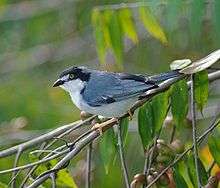Hooded tanager
The hooded tanager (Nemosia pileata) is a species of bird in the tanager family Thraupidae. It is found in Argentina, Bolivia, Brazil, Colombia, French Guiana, Guyana, Paraguay, Peru, and Venezuela. Its natural habitats are subtropical or tropical moist lowland forest, subtropical or tropical mangrove forest, and heavily degraded former forest.
| Hooded tanager | |
|---|---|
 | |
| Scientific classification | |
| Kingdom: | Animalia |
| Phylum: | Chordata |
| Class: | Aves |
| Order: | Passeriformes |
| Family: | Thraupidae |
| Genus: | Nemosia |
| Species: | N. pileata |
| Binomial name | |
| Nemosia pileata (Boddaert, 1783) | |
The hooded tanager was described by the French polymath Georges-Louis Leclerc, Comte de Buffon in 1779 in his Histoire Naturelle des Oiseaux from a specimen collected in Cayenne, French Guiana.[2] The bird was also illustrated in a hand-coloured plate engraved by François-Nicolas Martinet in the Planches Enluminées D'Histoire Naturelle which was produced under the supervision of Edme-Louis Daubenton to accompany Buffon's text.[3] Neither the plate caption nor Buffon's description included a scientific name but in 1783 the Dutch naturalist Pieter Boddaert coined the binomial name Tanagra pileata in his catalogue of the Planches Enluminées.[4] The hooded tanager is now placed in the genus Nemosia that was introduced by the French ornithologist Louis Jean Pierre Vieillot in 1816 with the hooded tanager (Nemosia pileata) as the type species.[5][6][7] The genus name is from the Ancient Greek nemos meaning "glade" or "dell". The specific pileata is from the Latin pileatus meaning "-capped".[8]
Six subspecies are recognised:[7]
- N. p. hypoleuca Todd, 1916 – north Colombia and north Venezuela
- N. p. surinamensis Zimmer, JT, 1947 – Guyana and Suriname
- N. p. pileata (Boddaert, 1783) – French Guiana through central Brazil to north Bolivia
- N. p. interna Zimmer, JT, 1947 – north central Brazil
- N. p. nana von Berlepsch, 1912 – northeast Peru and west Brazil
- N. p. caerulea (zu Wied-Neuwied, 1831) – east and south Brazil, southeast Peru to east Bolivia, Paraguay and north Argentina
References
- BirdLife International (2012). "Nemosia pileata". IUCN Red List of Threatened Species. 2012. Retrieved 26 November 2013.CS1 maint: ref=harv (link)
- Buffon, Georges-Louis Leclerc de (1779). "La coiffe noire". Histoire Naturelle des Oiseaux (in French). Volume 7. Paris: De L'Imprimerie Royale. pp. 401–402.
- Buffon, Georges-Louis Leclerc de; Martinet, François-Nicolas; Daubenton, Edme-Louis; Daubenton, Louis-Jean-Marie (1765–1783). "Tangara à coiffe noire, de Cayenne". Planches Enluminées D'Histoire Naturelle. Volume 8. Paris: De L'Imprimerie Royale. Plate 720 Fig. 2.
- Boddaert, Pieter (1783). Table des planches enluminéez d'histoire naturelle de M. D'Aubenton : avec les denominations de M.M. de Buffon, Brisson, Edwards, Linnaeus et Latham, precedé d'une notice des principaux ouvrages zoologiques enluminés (in French). Utrecht. p. 45, Number 720 Fig. 2.
- Vieillot, Louis Jean Pierre (1816). Analyse d'une Nouvelle Ornithologie Elementaire (in French). Paris: Deterville/self. p. 32.
- Paynter, Raymond A. Jr, ed. (1970). Check-list of Birds of the World. Volume 13. Cambridge, Massachusetts: Museum of Comparative Zoology. p. 276.
- Gill, Frank; Donsker, David, eds. (2019). "New World warblers, mitrospingid tanagers". IOC World Bird List Version 9.2. International Ornithologists' Union. Retrieved 4 October 2019.
- Jobling, James A. (2010). The Helm Dictionary of Scientific Bird Names. London: Christopher Helm. pp. 267, 306. ISBN 978-1-4081-2501-4.
External links
- Xeno-canto: audio recordings of the hooded tanager
- Hooded Tanager: Photos from "Avifauna of the Interior of Ceará, Brasil"
